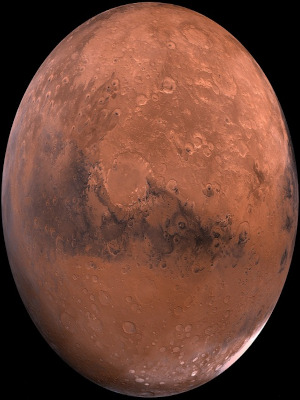Our solar system has a lot to discover, as well as a lot of unknown riddles and unsolved questions. For many people, the universe is something whose size lies beyond comprehension since it is infinite. Scientists like cosmologists and astronomers try to decipher the characteristics of the planets, and one is especially interesting for them: Mars.

Mars, which is also called the red planet because of its rusty coloration. This color is caused by minerals that contain a lot of iron. When these iron-rich minerals oxidize, then the soil takes on the red color. Mars is a neighbor planet of the earth and is the fourth planet from the Sun. The desert-like landscape is apparently without any life, and the planet has a quite thin atmosphere. Phenomenons like dust storms can occur and get so big that they occupy the entire Mars. Also, the temperatures can sink so low that the atmosphere turns into snow or frost because of its condensation. Mars has its name from the Romans, who called them after their war god “Mars”. In ancient Greece, the planet was called “Ares” after the Greek god of war.
Furthermore, Mars belongs to the terrestrial type of planet, which means that it is very rocky. In comparison to the Earth, Mars is smaller and further away from the Sun. Also, as far as the latest research could discover, Mars cannot be inhabited like Earth.
Mars has two moons that are called Phobos and Deimos. They were discovered by Asaph Hall, an astronomer from the USA. Both moons apparently consist of ice, which is mixed with carbon-rich rocks. On their surface, they have dust and rocks.
Mars is 6.791 km wide, and the gravitational pull there is 38% as strong as on Earth. This means that someone who weighs 80 kg on Earth would weigh about 30 kg on Mars.
About 4 billion years ago, Mars lost its magnetic field, which caused a lot of its atmosphere to get stripped by the solar wind.
Mars’ core consists of nickel, sulfur, and iron. The crust is composed mostly of iron, silicon, oxygen, and magnesium.
The time on Mars passes differently than the time on Earth, so that one Mars day is not 24 hours long but 24.6 hours (24 hours and 37 minutes). One year on Mars takes 687 days, so it is almost twice as long as one Earth year. The year has so many days because Mars’ ellipse-shaped way around the Sun is much longer than the Earth’s. An interesting fact about the second-smallest planet in our solar system is that one can see it well in a cloudless night sky. That is why people knew about its existence already in ancient times. Many unmanned space missions have already taken place on Mars, and we sent Mars rovers on them to measure and document everything. The first rover, named “Sojourner” was sent there in 1997.
Also, on Mars, there is the highest mountain that can be found in the solar system. It is a volcano named “Olympus Mons” and has a height of 24 km. That makes it around three times as high as Mount Everest.
To conclude, there is a lot more to discover about the impressive red planet, and maybe in the future, scientists will find traces of life on there.
Sources:
https://science.nasa.gov/mars/
https://spaceplace.nasa.gov/all-about-mars/en/
https://www.learningresources.co.uk/blog/10-facts-about-mars-for-kids/
https://www.natgeokids.com/uk/discover/science/space/facts-about-mars/
https://www.space.com/47-mars-the-red-planet-fourth-planet-from-the-sun.html
http://www.learningaboutelectronics.com/Articles/Weight-on-mars-conversion-calculator.php#answer
